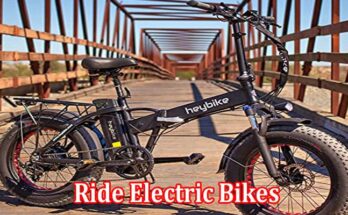In an era where environmental consciousness and urban mobility are trending topics, e-bikes have emerged as a game-changer.
Offering an eco-friendly alternative to traditional vehicles, they’re becoming an increasingly popular choice for daily commuting and leisure.
However, choosing an e-bike as your primary mode of transportation requires thoughtful consideration.
This article aims to guide you through the essential aspects of selecting the right e-bike, ensuring it meets your needs and lifestyle seamlessly.
Understanding E-Bike Basics and Benefits
E-bikes, or electric bicycles, are essentially bicycles equipped with an electric motor that provides assistance as you pedal. This feature makes them an excellent option for those who want to avoid the physical strain of traditional cycling, especially on hilly terrains or long commutes.
The benefits of e-bikes are extensive: they’re environmentally friendly, cost-effective in the long run, and can improve your fitness level without the same level of exertion as traditional bikes.
When considering an e-bike, it’s important to understand the different types available. There are pedal-assist e-bikes, which require the rider to pedal to activate the motor, and throttle-assist e-bikes, which can propel the bike without pedaling. Knowing the laws and regulations regarding e-bikes in your area is also crucial, as these can vary significantly.
E-Bikes for Daily Commutes
Assessing the distance of your commute is one of the first things you need to consider when figuring out how to choose e-bikes. E-bikes come with varying battery capacities, and you’ll need one that can handle your daily mileage without frequent recharges. The terrain is another critical factor. If your route involves hills or rough trails, look for an e-bike with a more robust motor and possibly suspension features.
Comfort is paramount. Make sure the e-bike fits your body well and that the seat, handlebars, and frame size are suitable for your height and riding style. Additionally, consider the weight of the bike, especially if you’ll need to carry it upstairs or onto public transportation.
Safety features, such as lights, reflectors, and a reliable braking system, are also essential, particularly if you’ll be riding in traffic or during darker hours. Storage options, like racks or baskets, can add convenience for carrying personal items or groceries.
E-Bike Maintenance and Longevity
Maintaining an e-bike is not drastically different from maintaining a traditional bike, but there are some additional aspects to consider. The battery, being the heart of the e-bike, requires particular attention. Regularly check its condition and charge it as recommended by the manufacturer to ensure a longer lifespan.
Regular maintenance checks should include the brake system, tire pressure, and the motor’s condition. It’s also important to keep the bike clean, as dirt and grime can affect its performance and longevity. If you’re not comfortable performing these checks yourself, regular servicing by a professional is advisable.
Consider the availability of spare parts and the manufacturer’s warranty. Opting for a brand with a good reputation and accessible customer service can save you a lot of hassle in the long run.
Cost Considerations and Budgeting
While e-bikes can be more expensive upfront than traditional bicycles, they are an investment. The initial cost should be weighed against the potential savings in fuel, public transportation costs, and even gym memberships. However, it’s important to set a realistic budget and stick to it.
When budgeting for an e-bike, don’t forget to factor in the cost of accessories, maintenance, and potential repairs. Some e-bikes might require specific components that can be costly to replace. It’s also worth considering insurance for your e-bike, especially if it’s a high-end model.
Look for value over the cheapest option. A slightly more expensive e-bike might offer better durability, battery life, and overall riding experience, which can be more cost-effective in the long run.
Integrating E-Bikes into Your Lifestyle
Adopting an e-bike as your primary transportation mode is more than a purchase—it’s a lifestyle change. Integrating an e-bike into your daily routine requires planning and adaptation. Start by mapping out your regular routes and consider any challenges, like steep hills or longer distances, that an e-bike can overcome more easily than a traditional bike.
Think about your daily activities: commuting to work, running errands, or leisure rides. An e-bike’s versatility can cater to all these needs efficiently. If you’re used to driving, consider how switching to an e-bike can reduce your carbon footprint and contribute positively to the environment.
Another aspect is the social element. Joining e-bike communities or groups can enhance your riding experience. These communities often share tips, organize group rides, and provide support for new e-bike users.
Safety and Legal Considerations
When transitioning to an e-bike, safety and legal considerations are paramount. Firstly, familiarize yourself with the local laws regarding e-bikes. Regulations can vary significantly, from speed limits to where you can ride (bike lanes, roads, trails). Ensure your e-bike complies with these regulations to avoid legal issues.
Investing in safety gear, such as a high-quality helmet, reflective clothing, and appropriate lights, is essential. These not only protect you but also make you more visible to other road users, especially in low-light conditions.
Understanding the traffic rules and how they apply to e-bikes is crucial. This includes signaling turns, obeying traffic lights, and understanding right-of-way rules. Remember, just because you’re on an e-bike doesn’t mean you’re exempt from the rules that apply to traditional bicycles and vehicles.
Finally, consider taking a safety course, especially if you’re new to cycling or coming back after a long hiatus. These courses can provide valuable tips on handling your e-bike in various traffic situations, ensuring you ride safely and confidently.
Conclusion
Choosing an e-bike as your primary means of transportation is a decision that aligns with modern, eco-conscious living. It offers a blend of convenience, health benefits, and environmental friendliness.
By understanding the basics, considering your commuting needs, factoring in maintenance and cost, and choosing a bike that fits your lifestyle, you can make an informed decision that enhances your daily travel.
Remember, the right e-bike is not just a vehicle; it’s a step towards a healthier, more sustainable way of life.




